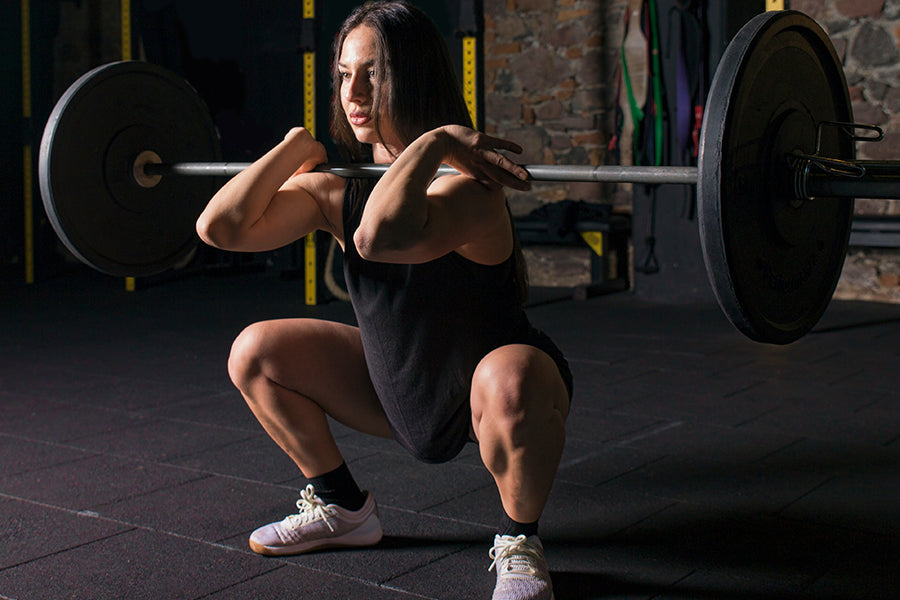We all have those days when we can't decide what to wear. We stand in front of our closet for hours, trying to piece together an outfit that represents our personality but also looks good.
The same thing can happen when we're trying to choose between two exercises — the front squat and the back squat. So how do you decide which one is right for you? Let's take a keen look at the pros and cons of each exercise to help make your decision a little easier.
What are Front Squats Good for?
When it comes to squats, there are a lot of different variations that you can do. But when it comes to front squats, what are they good for? Well, for starters, front squats are great for targeting your quads.
And if you’re someone who struggles with ankle range of motion, then front squats are a great option for you. Because the weight is in-front of you, you can push your centre of mass further back creating more mid-foot pressure when squatting. Additionally, front squats are also great for improving your posture since you have to keep your chest and shoulders back when doing them.
So if you want to improve your lower body strength and build bigger quads, then front squats are the way to go. To do the front squat,
- Start by holding a barbell on your front side and carefully rest it on your shoulders.
- Engage your fingers in an underhand grasp right outside your shoulders and push your elbow vertically toward the ceiling.
- Start squatting by beginning the movement with your hips, bending the knees, and then dropping your hips towards the ground.
- To perform an error-free front squat, ensure that your chest stays up and your knees fall out.
- Stay upright so the weight doesn't fall forward.
Related Article: Workout Plan to Build Stronger Core & Strength
What is the Purpose of a Back Squat?

It allows you to safely and effectively increase the amount of weight you are lifting, as well as improve your form. The back squat also targets the quads, hamstrings, and glutes, making it an ideal exercise for building lower body strength.
In addition, the back squat can help improve your mobility and range of motion. Keeping your spine in a neutral position and using a wider stance can increase your mobility and reduce your risk of injury.
As a result, the back squat is an essential exercise for any weightlifter looking to improve their strength, size, and form. To do the back squat,
- Start by holding the barbell behind your head and resting it on your shoulder traps.
- Stand with your feet shoulder-width apart, toes vaguely pointed out, and chest raised.
- Now sit back into your hips, bending your knees and dropping your hips towards the ground. Make sure you push your knees out, and your gaze stays in front.
- Finally, when your thighs get parallel to the ground, hold yourself for a moment and then stand up, pushing through your whole foot back to start.
Related Article: Get an Impressive Upper Body With 20-Week Chin Up & Dip Program
Do They Work the Same Muscles?
You could say that both types of squats work the same muscles because they are, well, squats. But that would be like saying that all animals are the same because they're all animals. A cat and an elephant are both animals, but they're not exactly alike, now are they? The same can be said of front squats and back squats.
They both work the quads, glutes, and hamstrings, but in different ways. For example, front squats place more emphasis on the quads, while back squats target the glutes and hamstrings more.
So if you want to work those quads, do some front squats. But if you're looking to build a booty like Beyonce, you should focus on back squats. In short, it all depends on your goals. But whether you do front squats or back squats, just remember to keep good form and listen to your body.
Both front squats and back squats offer a lot of benefits. They're great for building lower body strength, improving balance, and increasing flexibility. However, there are some primary differences between the two exercises.
For one, front squats tend to be more quad-dominant, while back squats are more hamstring-dominant. This means that if you're specifically targeting your quads, then front squats are the way to go. On the other hand, if you want to focus on your hamstrings, then back squats are a better option.
Related Article: 4 Weighted Conditioning Workouts to Replace Your Cardio Deck
What are the Most Common Mistakes in Each Type?
You can make multiple mistakes while trying a new workout, so to avoid the mistakes and prevent any injury, read here the mistakes commonly made while trying back squats and front squats.
Back Squats
Here are some mistakes commonly made while trying back squats.
Knees Caving Inward
Don’t allow your knees to collapse inward. Drive them out slightly as you ascend and descend.
Lack of Depth
The significant aspect of this exercise lies in ensuring your thighs are parallel with the ground, reaching depths from where they can provide their full potential, and avoiding any injuries below.
Chest Dropping
Keep in mind to engage your posterior chain. When you let yourself fall forward, this disengages the muscles of the spine and hip, which are needed for proper form. To fix it, simply roll down those shoulders as if making expansive gestures with hands out front while keeping your gaze focused on the target indication.
Front Squats
Read the following mistakes to perform an error-free exercise.
Elbow Dropping
The elbows should be raised to meet the bar during a front squat. This will ensure that you sit back into your hips rather than relying on momentum alone, which could cause injury if done incorrectly.
Not Sitting on Heels
The front squat is more challenging than the back one because you must resist falling forward when executing it. To do so, think about dropping straight into your heels while sitting on balled-up feet and allowing gravity to take over.
Upper Back Rounding
The front squat is a move that will work your lower back, but it's important to keep the spine straight and maintain good posture for proper alignment. This ensures you get all this great training effect without any negative impact on other areas like shoulders or knees.
What’s the Difference Between a Front Squat and a Back Squat?
Let’s take a closer look at the two types of squats to see the difference.
Front squats are an amazing exercise for building lower-body strength. The main difference between a front squat and a back squat is that in a front squat, the barbell is held across the front of your shoulders, while in a back squat, the barbell is held behind your neck.
Because the barbell is in front of your body in a front squat, keeping your torso upright is easier, which means you’re less likely to round your back during the exercise. This can be helpful if you have lower back pain or are new to squatting.
Back squats are a bit more challenging than front squats, but they offer some unique benefits. When you do a back squat, the barbell is placed on your upper back, which allows you to use more weight than you could with a front squat. This makes back squats ideal for building muscle and increasing strength. Additionally, because the barbell is placed on your upper back, it forces you to keep your torso more upright, which can help improve your posture.
So, what’s the difference between a front and back squat? Both exercises have their benefits, so it depends on your goals. If you want to build muscle and increase strength, back squats are probably the best option. If you’re new to squatting or have lower back pain, then front squats might be a better choice.
Ultimately, the best exercise for you is the one that you enjoy doing, and that helps you reach your fitness goals.
Related Article: 10 Dumbbell Exercises for Stronger Legs Without Going to the Gym
FAQs
1. What is the difference between a back squat and a front squat?
Front squats are great for targeting your quads and help build strength and flexibility. The back squat also targets the quads, hamstrings, and glutes, making it an ideal exercise for building lower body strength.
2. What are the benefits of front squats vs. back squats for athletes?
Front squats are often recommended for athletes who want to improve their vertical jump, as they mimic the jumping motion better. On the other hand, back squats are often recommended for athletes who want to build lower-body strength, as they more effectively target the quads and glutes.
3. Which squat is better for building mass?
When it comes to building mass, there are two schools of thought: go heavy or go light. For years, bodybuilders have been squatting with heavy weights in an attempt to build bigger muscles.
However, lighter squats can be just as effective for muscle growth. The key is to use a challenging but not too heavy weight. When done correctly, lighter squats can help build muscle while protecting the joints and preventing injuries.
4. How much weight should I be lifting for each type of squat?
There's not a single answer to this question, as the weight you should be lifting for each type of squat will depend on your strength and fitness levels. However, some general guidelines can help you determine how much weight to lift.
For instance, if you're doing a bodyweight squat, you'll likely be able to do more reps with a lighter weight than if you were using a barbell. On the other hand, if you're doing a barbell squat, you'll need to use a heavier weight to get the same results.
The Bottom Line
Front squats and back squats have slight differences and can benefit people who know what changes they want for their bodies. So, there you have everything you need to know about front and back squats and why they’re amazing for building lower-body strength. If you’ve been looking for a new exercise to add to your routine or want to learn how to squat correctly, start incorporating front and back squats into your workouts today.
Reading List
Article Sources
- Lorenzetti, Silvio, et al. ‘How to Squat? Effects of Various Stance Widths, Foot Placement Angles and Level of Experience on Knee, Hip and Trunk Motion and Loading’. BMC Sports Science, Medicine and Rehabilitation, vol. 10, July 2018, p. 14. PubMed Central, https://doi.org/10.1186/s13102-018-0103-7.
- Myer, Gregory D., et al. ‘The Back Squat: A Proposed Assessment of Functional Deficits and Technical Factors That Limit Performance’. Strength and Conditioning Journal, vol. 36, no. 6, Dec. 2014, pp. 4–27. PubMed Central, https://doi.org/10.1519/SSC.0000000000000103.
- Gullett, Jonathan C., et al. ‘A Biomechanical Comparison of Back and Front Squats in Healthy Trained Individuals’. Journal of Strength and Conditioning Research, vol. 23, no. 1, Jan. 2009, pp. 284–92. PubMed, https://doi.org/10.1519/JSC.0b013e31818546bb.











